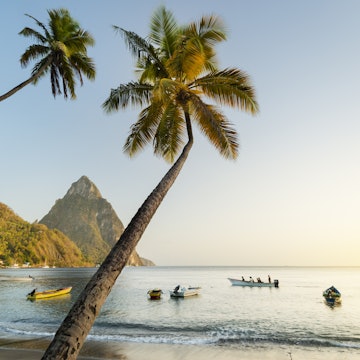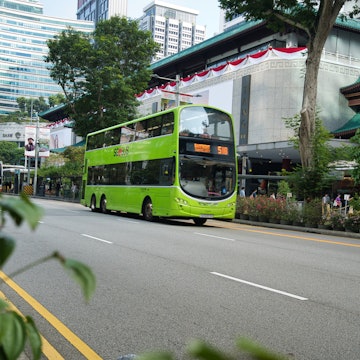

Plan for your trip to Singapore with these things you should know and insider tips © Jakub Zajic / Getty Images
Singapore has a well-cultivated image of being a safe country.
Too safe perhaps for some, who balk at its infamously strict rules and fines for flouting them, and find the gleaming modern city too sanitized for their liking. Others appreciate the clean streets and manicured gardens amidst the tall buildings along with the intriguing mix of people that make up Singapore’s multifaceted culture.
As a Singaporean who’s lived here all her life (and who has always had to explain the country to fellow travelers in foreign hostel common rooms) here’s what you need to know about Singapore, its cultural landscape, and its local customs and quirks, to help you plan your trip to the Little Red Dot.
1. Singapore is small, but with lots to see and do
Compact Singapore takes less than an hour to drive from end to end but there’s a lot packed into this small country. For a first-time visitor, three to four days is usually sufficient to see the main highlights and get a feel of the top things to do in Singapore.
If you’re really short on time, plan a layover with at least 5.5 hours and you can join one of three free transit tours organized by the excellent Changi Airport for a quick taster of what the country has to offer.

2. Pack for the tropics
Practically located on the equator, expect hot tropical weather ranging from 25 to 35ºC (77 to 95ºF) every single day in Singapore. A small umbrella is essential in case of scorching rays or sudden downpours.
What can be tough for those used to temperate climates is Singapore’s high humidity – 60 to 90% on average throughout the year, so be prepared to sweat it out. Pack light materials or bring a small fan or hankie around with you. Anyone basking under the afternoon sun who’s not on the beach is definitely a tourist – be sure to slap on the sunblock!
Funnily enough, it tends to be a lot colder indoors than outdoors because shopping malls and central cooling overcompensate for the heat.
A scarf or a light jacket will keep you warm, offer extra sun protection and are the perfect cover-up if you plan to visit religious buildings.
3. Singapore is an independent country
With a majority Chinese population, some people mistakenly assume that Singapore is a part of China, which is not the case. Most Chinese Singaporeans are descendants of southeastern Chinese immigrants who sailed across the seas decades ago.
Singapore may be hard to spot on a map, but you’ll find it just south of the Malaysian peninsula in Southeast Asia, four hours away from China by plane. On that note, despite its proximity and commonalities in shared culture and history, Singapore is also not a part of Malaysia, though it was very briefly back in 1963 before Singapore became fully independent in 1965, making next year – 2025 – the 60th anniversary of the republic.
4. Most Singaporeans speak excellent English
Singapore is an easy place for Western tourists to explore on their own because of the widespread use of English here. Fun fact: Singapore actually has four official languages: Mandarin, Bahasa Melayu and Tamil represent the three major ethnic groups found here (Chinese, Malay and Indian respectively), and English is the main language used in schools and for business, which also allows for conversation across ethnicities.
5. Natural disasters are unlikely in Singapore
Singapore may not have scenic mountain ranges or awe-inspiring topography, but it’s also out of the path of any major tectonic movement. You are unlikely to face any major natural disasters – no earthquakes, volcanos, typhoons or sandstorms here.
In the worst case, there may be flash floods during particularly rainy periods or haze blanketing the island from forest fires around the region, but these are usually temporary and minor inconveniences.
6. Singapore is a safe and stable place to visit
Singapore is also well-known for its generally stable political and business climate, often ranked as one of the least corrupt countries in the world. Strikes that can disrupt travel plans are practically nonexistent here.
The crime rate in Singapore is also relatively low with lots of surveillance and a police force that people trust in. As a single woman, I’ve never been too worried about wandering around Singapore on my own even at night, but do maintain some common sense for your own safety as one of our popular slogans here goes: low crime doesn’t mean no crime.

7. Carry both cash and credit cards
How many Singapore dollars you change before your trip largely depends on where you plan to go. Most major tourist attractions and shops in shopping malls will accept credit cards, and other cashless options like contactless payments and smart wallets are also common.
Those planning to take public transport in Singapore can use their credit cards on the public buses and MRT card readers for convenience, but purchasing a local EZ-Link card or transport pass may be more worthwhile depending on how much travel you plan to do. However, do carry some cash around with you as it remains the prevalent method of payment for most small businesses, eating at hawker center stalls, or taking a taxi. Try to break notes of larger denominations ($50/$100) into smaller ones ($2/$5/$10) when possible.
8. Prebook attractions to avoid waiting in line
There’s a joke that a Singaporean’s favorite pastime is to queue for things, but that’s not something you want to waste time on. If there is an option to prebook tickets online or make a reservation, just do it. This is key on busy weekends and peak vacation periods like the mid- and year-end school holidays.
An attraction’s official website is usually the best place to get tickets, but browse other booking platforms before you check out as these sites may offer special seasonal discounts or multi-bundle prices. Also check the Visit Singapore website as it sometimes runs incentive programs for tourists.

9. Tipping is not expected
Tipping is not expected in Singapore. If you’re eating out in a restaurant or cafe, there is usually a 10% service charge included in the bill. Some places may have a tip box but otherwise, additional tips are not mandatory or expected, though they are appreciated in the service line.
10. Understand the art of "chope-ing"
If you are eating at food centers or working at co-working spaces, particularly within the central business district, you may notice empty tables with strategically placed items like umbrellas, tissue packets or lanyards on the seats. This is a local practice to "chope" or reserve a seat while everyone is queuing up at the stalls. Most people honor this informal reservation system and will look elsewhere for available seats.
11. Yes, you can drink the tap water
There's no need to buy bottled water in Singapore. The tap water here is treated and perfectly safe to drink. You'll find that most attractions have water coolers where you can refill your reusable bottles while you're out and about during the day.













